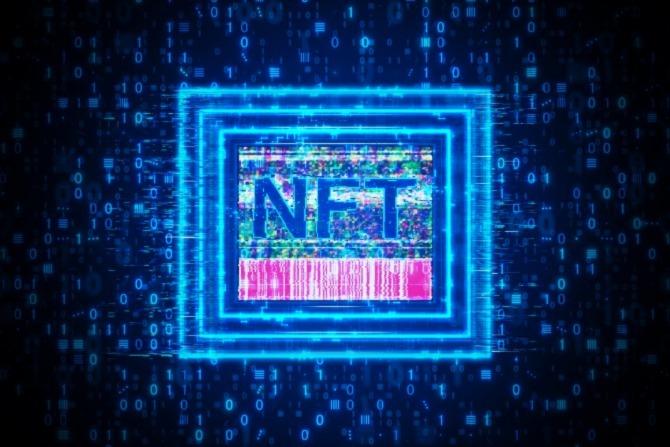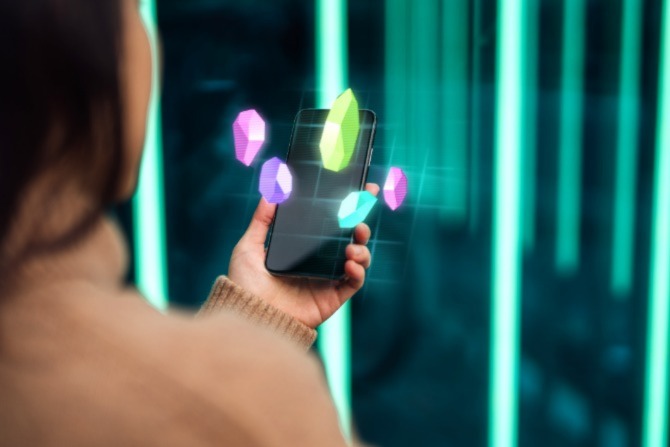
Although the technology has been around for a while, NFTs took off in 2020 and have been growing in popularity ever since, particularly in the digital art world. NFTs have generated great excitement but at the same time have been criticized for being volatile and highly speculative and vulnerable to scams. In this article we look at what you need to know about NFTs
NFT meaning and definition
NFT stands for ‘non-fungible token’. Non-fungible means that something is unique and can’t be replaced. By contrast, physical money and cryptocurrencies are fungible, which means they can be traded or exchanged for one another. Every NFT contains a digital signature which makes each one unique. NFTs are digital assets and could be photos, videos, audio files, or another digital format. NFT examples include artwork, comic books, sports collectibles, trading cards, games and more.
How do NFTs work?
Non-fungible tokens or NTFs are cryptographic assets which sit on a blockchain – that is, a distributed public ledger that records transactions. Each NFT contains unique identification codes that distinguish them from each other. This data makes it easy to transfer tokens between owners and to verify ownership.
NFTs hold a value which is set by the market – i.e., supply and demand – and they can be bought and sold in the same way that physical assets can. NFTs are digital representations of assets – and can also represent real-world items such as artwork and real estate. Tokenizing real-world tangible assets in this way is considered by some users to make buying, selling and trading them more efficient, as well as potentially reducing the likelihood of fraud.
How do you buy NFTs?
The NFT market is considered high risk, and its volatile highs and lows can deter even experienced investors. If you are thinking of buying NFTs, it’s important to have a clear understanding of the process. Let’s look at the steps involved:
Open a crypto exchange account
The first step is to open an account on a crypto platform or crypto exchange. A crypto exchange is an online platform where you can buy and sell different types of cryptocurrencies. To buy NFTs, you need to create an account with your chosen platform. Different platforms offer different services, so it’s worth researching them to find out which suits you best in terms of features, fees, and ongoing support.
Open a crypto wallet
A crypto wallet stores the keys that grant access to your digital assets. Users are given a unique seed phrase – also called a recovery phrase – to access their wallet. It’s essential to keep your seed phrase safe – without it, you lose access to your wallet.
Wallets can either be hosted on an exchange or may operate independently. If they operate independently, then you retain responsibility for your wallet and private keys. If your digital wallet is hosted by an exchange, the exchange acts as an intermediary for crypto transfer. The company holds your private keys and is responsible for keeping your assets safe.
Alternatively, if you want to buy and sell NFTs without third-party involvement, you need a wallet tied directly to the blockchain. This allows currency to be transferred directly between people using the public key. The two types of wallet available are called ‘hot’ or ‘cold’:
Hot wallets are:
- Software, web-based wallets
- Available as a desktop or mobile app, in-browser extension or both
- More vulnerable to cyber attacks than cold wallets
Cold wallets are:
- Hardware wallets, physical devices not connected to the internet
- Considered more secure
- However, at greater risk of loss and have no backup available if you lose your seed phrase
Whichever crypto wallet you select should ideally be compatible with the Ethereum blockchain, since that is the network on which most NFTs are sold, and Ether (ETH, Etherium), which is the cryptocurrency native to Ethereum blockchain.
Transfer Ethereum into a crypto wallet
Once you have selected an NFT exchange and bought ETH, you then need to transfer it to a wallet. This process will vary depending on the exchange through which you buy ETH, the wallet you use, and the marketplace on which you plan to trade NFTs.
Buy NFTs
Once your wallet is connected and funded, you can start buying NFTs. When you buy an NFT, you gain ownership in the sense that it becomes your property. However, the NFT holder doesn’t have other rights to the work – such as the right to adapt or reproduce it – unless that is part of the direct agreement between the buyer and creator. Different marketplaces may place varying restrictions on the NFT you purchased.
What is an NFT marketplace?
The NFT landscape is evolving, but typically, most NFT marketplaces fall into one of these three categories:
- Open marketplace – Anyone can sell, buy or mint NFTs. Minting refers to the process of uniquely publishing your token on the blockchain to make it buyable. Open marketplaces typically mint NFTs for you, though creators can also mint their own works.
- Closed marketplace –Artists must apply to join and the marketplace usually undertakes the minting processes. Selling and trading are more restricted.
- Proprietary marketplace – A marketplace which sells NFTs trademarked or copyrighted by the company operating it.
Some NFT traders create accounts on and subscribe to a variety of marketplaces so they can receive announcements about new NFT drops. Information about new NFTs is also shared on platforms such as Discord and Twitter, as well as more specialized investing platforms like Rarity Sniper and Rarity Tools. When highly anticipated NFTs are released, investors tend to act quickly.
Most marketplaces offer step-by-step guides which help users understand how to use them. Once you have created a marketplace account, you should connect your wallet to the marketplace. Some marketplaces allow you to set up a new wallet from within the website, or they use their own proprietary wallet. Using a marketplace’s proprietary wallet might come with discounts or a reduction in the additional fees incurred by using external wallets.

alt= “NFT art on a mobile phone”
Examples of NFT marketplaces
There are dozens of NFT marketplaces. Examples include:
OpenSea
One of the largest NFT marketplaces, OpenSea, offers NFTs in a number of areas – art, music, fashion, sports, games, and collectibles. The site also offers various learning resources for users.
NBA Top Shot
An NFT marketplace where sports fans can trade basketball video clips. NBA Top Shot has a large community of followers, and contests and challenges provide a social aspect.
Nifty Gateway
Nifty Gateway offers collections from well-known multi- and mixed-media, video, fine art and animation artists. The site is aimed at buyers whose goal is to collect or trade art with long term value.
Rarible
An Ethereum-based platform that facilitates the creation, sale, and purchase of ownership rights to digital works of art via NFTs.
NFT scams
NFTs scams are not uncommon. some of the main ones to watch out for include:
- Phishing scams – Deceptive links and pop-ups promoting new NFT projects and drops on social media.
- Catfishing – Fake marketplace websites, social media accounts, and celebrity impersonators advertising NFT drops and collections.
- Counterfeit NFTs – Scammers selling other people’s work as if it is their own original work.
- Pump-and-dump schemes – Scammers building hype around an NFT so it sells at a high price – but then quickly cashing out, leaving investors with worthless assets.
- Free mint scams – Scammers use high pressure tactics to lure users to participate in a deceptive mint. But instead of receiving a new mint, the victim instead inadvertently signs away the rights to control their wallet.
To avoid falling victim to an NFT scam:
- Observe essential cybersecurity practices, such as strong passwords and two-factor authentication.
- While storing your crypto on exchanges is convenient, it is safer to store it in a cold wallet – i.e., a hardware device where keys and assets are stored offline.
- Before investing significant sums in NFTs, carry out an initial transaction with a small amount of money first to make sure everything is working as it should.
- Ignore spam, such as DMs or odd NFTs that strangers send to your wallet, which can have malicious contracts attached.
- Before you buy NFTs, research how to keep both your information and cryptocurrency safe. Read online guides, reviews and testimonials to understand the market and the risks involved.
You can read our full article on NFT scams and how to avoid them here.
FAQs about NFTs
What does NFT stand for?
NFT stands for non-fungible token. Non-fungible is an economic term which refers to things that are not interchangeable with other items because they have unique properties.
What is an example of an NFT?
NFTs began in the digital art world, but you can now buy many different types of NFTs, including music, sports highlights, video games, fashion, trading cards, event tickets, memes, domain names, and more. Famously, Twitter founder and CEO Jack Dorsey’s first tweet was sold as an NFT in 2021 – although subsequent media reports suggested this didn’t turn out to be a good investment for the person who bought it.
Are NFTs cryptocurrency?
NFTs and cryptocurrencies share some similarities but also have important differences. The main difference is that cryptocurrencies are fungible and NFTs – as their name suggests – are non-fungible. What this means is that one Bitcoin (for example) equals another Bitcoin, but one NFT doesn’t equal another NFT. Each NFT asset is unique and its value is determined by market forces.
What are NFTs used for?
NFTs are tokens used to represent ownership of unique items. NFTs allow their creators to tokenize things like art, collectibles, or even real estate. They are secured by the Ethereum blockchain and can only have one official owner at a time. No one can change the record of ownership or copy/paste a new NFT into existence.
What is NFT digital art and how does NFT art work?
NFT art refers to digital assets which are collectible, unique and non-transferable. Once NFT art is created, it is tokenized or minted on the cryptocurrency service called blockchain. Blockchain is a digital transaction system which records information in a way that is difficult to hack or scam. This makes it useful for tracking copyright ownership and maintaining records of creation – hence why it has become popular in the digital art world.
Recommended products:
- Kaspersky Anti-Virus
- Kaspersky Total Security
- Kaspersky Internet Security
- Kaspersky Password Manager
- Kaspersky Secure Connection
Further reading:


